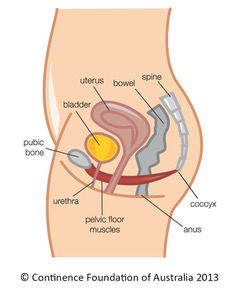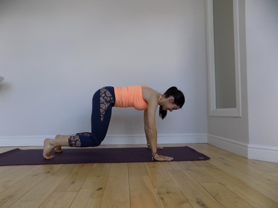The pelvic floor! The area that takes the burden during pregnancy and labour, yet there is not enough information about it and it is not talked about enough. It is estimated that 3 in 4 mothers will experience pelvic problems later in life from birth-related problems, and once help is sought, 25-40% of women have a reduced awareness of how to exercise their pelvic floor muscles and contract them properly. (1).
Pelvic floor muscle exercises are recommended to commence by week 10 of pregnancy and be continued throughout pregnancy and postnatally (2). It is a misconception that those who have a caesarean section will not be affected by their pelvic floor. The pelvic floor is already working hard throughout your pregnancy. Learning this skill at the earliest convenience could assist your pregnancy AND help prevent complications later down the line.
What is your pelvic floor?
The pelvic floor unit supports the base of your pelvis and all the internal organs inside it. The pelvic floor extends from your pubic bone at the front to your sacrum/coccyx region at the back, and from the inner side from a muscle called obturator internus to the outer aspect of your greater trochanter (thigh bone). These muscles can be exercised in the same way normal skeletal muscle can be.

Schematic diagram of the pelvic floor: Note how the pelvic floor muscles run from the pubic bone at the front to the coccyx at the back. The bladder, uterus and bowel are all supported by this band of muscles (3).
Pelvic floor during pregnancy
As the baby grows and places greater pressure within the pelvis, this pressure creates a downward force on to the pelvic floor. In combination with ligament laxity here, the pelvic floor muscles can become weakened. This laxity can last up until 5 months postpartum, and longer if breastfeeding (4). These muscles are responsible for supporting the bladder, rectum and uterus. They ensure correct functioning of these organs by assisting the closing force of the bladder and bowel passages to prevent leakage, and allowing relaxation for effective emptiness.
Pelvic floor muscle dysfunction
Dysfunction of the pelvic floor can leak to urine or faeces incontinence, organ prolapse, localised pain, and painful sex. It has also been related to lower back pain and pelvic pain postnatally (5).
Risk factors for developing dysfunction include (6):
- Complications with vaginal delivery
- High birth weight of greater than 4kg
- Three deliveries or more
- Birth of twins or more
- Chronic constipation
- Increased maternal age
How pelvic floor muscle training can help!
Training these muscles as per the guidelines has been shown to reduce the risk of urinary incontinence by 50% when performed prenatally, and 35% when performed postnatally (6).
Working the pelvic floor muscles also helps strengthen your core muscles, leading to a better core/trunk support and therefore can ease lower back pain & pelvic girdle pain, and many other musculoskeletal pains associated with pregnancy.
How the pelvic floor and your core work together
There is now vast amounts of evidence that demonstrates that the pelvic floor and core muscles work together. As you contract your pelvic floor and gently lift upwards, your core muscles will also contract. Where the emphasis is (pelvic floor or core) can be altered based on where you focus your attention, but contraction of one area will always result in the co-contraction of the other.
When you are exercising try to firstly lift your pelvic floor upwards from the back to the front passages, and then activate your core muscles at your lower stomach area. To do this you want to isolate the outer abdominal muscles in line with the hip bones at the front. Draw them in towards you gently. This should feel like a corset of support around your lower trunk region, and below your pelvis.
Essential exercises for your pelvic floor muscles!
Ideally these exercises should be completed daily by every woman (and man!) for optimal pelvic floor health, however it is especially important during pregnancy. NICE guidelines recommend starting them by your 10th week of pregnancy and continuing daily throughout pregnancy and postnatally. If you have not done these before though it is never too late to start and the sooner you start the faster you will strengthen these muscles and promote pelvic floor recovery.
How to perform a pelvic floor muscle contraction:
Focusing on the pelvic floor muscles, from your back passage to your front passage, gently draw them inwards and upwards. Imagine you are closing up your anal and vaginal passages to prevent any bowel or urinary movements.
If there were 10 different levels, you want to imagine drawing the muscles upwards to level 3. This ensures the contraction is effective but not overpowering. Over contracting can lead to discomfort.
(NOTE: Never actually stop yourself from going to the toilet, this is a visual tool only).
There are two different ways to complete these contractions because the pelvic floor is made up of two different types of muscle fibres.
- FAST contractions
This method works on the activation and efficiency of the pelvic floor muscles.
Contract the muscles and then let go fully again. Do not hold the contraction.
Repeat for 10 consecutive repetitions.
- SLOW contractions
This method builds muscle endurance and strength.
Contract the muscles and hold this contraction for 10 seconds, then relax fully.
Repeat for 10 consecutive repetitions.
As you get stronger and can achieve this 10 x 10 seconds, try to hold the contraction for longer and eventually build up to 1 minute.
Aim to complete BOTH types of pelvic floor muscle exercises 3 x per day. Ensure you relax completely in between each repetition. It can take 3-5 months for full benefits to occur so do not be put off if you do not notice changes initially, but rather continue with your exercises. If there is still no improvement then contact a women’s health physiotherapist for assessment and advice, or speak to your GP.
Other tips
- Stay well hydrated to reduce constipation
- Eat a high fibre diet to reduce constipation
- Engage your core and pelvic floor before any strenuous activities, lifting, or exercise
- Consider reducing your caffeine intake as caffeine acts as a diuretic and can irritate the bladder
- Consider changing from high impact exercise to low impact to reduce stress on the pelvic floor
- Ensure core type exercises are lower load on the pelvic floor and abdominals
To read more about exercising in pregnancy read this post here on The Complete Antenatal Exercise Guidelines.
How to modify your core exercises to reduce load on your pelvic floor:
Try these Pregnancy Pilates home workouts to help you work on your core, pelvic floor, and maintaining strength throughout your pregnancy.
- Avoid doing any sit up type exercises or exercises where you raise your head up off the ground too far as these increase intra-abdominal pressure and place extra pressure on your pelvic floor.
- Avoid full plank positions as this is very demanding on the core and pelvic floor. Instead try doing these on your knees, or see the alternative exercise in the picture below.
- Avoid holding any modified plank position exercises for long durations as your muscles may not have enough endurance yet to hold the position comfortably. Instead, try the exercise shown below, and also hold for a shorter duration and try doing a few repetitions, with a rest in between each one.
- Avoid exercises that involve raising both legs up in the air at the same time, or lowering both legs down from a raised position.

Modified plank exercise: Commence on your hands and knees with your wrists under the shoulders, and knees under your hips. Engage your core. Press your toes and hands in to the ground and gently raise up a few inches, hovering your knees. Maintain a straight back as shown below. Hold for 3-5 seconds, then return to the mat.
References
1. Lee D.G. et al. 2014. J Assoc of Chartered Physiotherap in Women’s Health. 114; 10–24.
2. NICE 2013. CG171.
3. Diagram: https://www.continence.org.au/pages/how-do-pelvic-floor-muscles-help.html
4. Gabbe D.G. 2012. Obstetrics: normal and problem pregnancies. 6th edition. Saunders.
5. Pool Goudzwaard A., et al. 2004. Clin Biomechanics. 19: 564-571.
6. Lee D.G. et al. 2008. J Bodywork and Movement Ther. 12: 333-348.
7. Br J Sports Med 2018;52:1339–1346. doi:10.1136/bjsports-2018-100056
